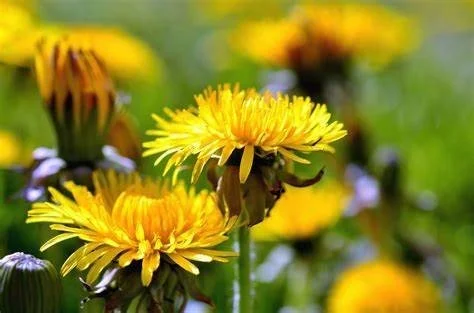Dandelion – Part 2 - Medicinal and culinary uses
A feast for the eyes in the meadow, an underestimated medicinal plant, a versatile herb in the kitchen - Taraxacum has many facets.
The common dandelion, which is widespread in the northern hemisphere, can be found everywhere: in cracks in walls, on the side of the road, on rubble heaps and fallow land. It grows in large quantities in meadows and fields that have been fertilized with animal manure and therefore contain a lot of nitrate that other plants cannot tolerate. Nitrate itself is considered to be of little health risk. However, it can be partially converted into nitrite by bacteria (e.g. in the stomach) and as such can form carcinogenic nitrosamines with protein compounds.
Many people will be familiar with the name Taraxacum officinale for the dandelion from the daisy family. Since 2011, the term Taraxacum sect. Ruderalia has been agreed upon, as the section (subspecies) consists of many very similar and difficult to distinguish species. Most of these species are simply referred to as dandelions.
Dandelions are not poisonous
The fact that dandelions are often considered toxic is due to the milky sap in the plant. For good reasons, children are taught that plants with milky sap can be poisonous and should not be put in their mouths. However, dandelions have been proven to be non-poisonous. So children can safely make wreaths out of the flowers and blow away the fruit clusters.
Medicinal plant recognized by medical authorities
Dandelions contain valuable vital substances in all parts of the plant and are considered to be an all-rounder among medicinal plants. The herb and roots contain remarkably large amounts of vitamins C and A; in addition, there are all B vitamins and vitamin E.
Dandelions also have unusually high concentrations of potassium and calcium; they also contain the minerals sodium, phosphorus, magnesium and the important trace element selenium.
The bitter substances (they contain sesquiterpene lactones) are particularly important. In combination with other health-promoting natural substances (triterpenes, flavonoids), the bitter substances have a major impact on health. They alleviate loss of appetite, relieve feelings of fullness and flatulence, promote digestion, have a positive effect on many metabolic processes, improve the production and drainage of bile, thereby helping with fat digestion and have a liver-protecting effect.
An increase in the amount of urine has also been proven, which can promote flushing in cases of mild urinary tract problems. The diuretic effect develops in the kidneys due to the high potassium content; there the mineral stimulates increased water excretion The European Scientific Cooperative for Phytotherapy ( ESCOP) writes: Dandelion is supportive in treatments where an improved urine flow is desired, e.g. in rheumatism and to prevent kidney stones.
Contraindications: Anyone who is allergic to Asteraceae should also avoid dandelion.
You can stock up by drying the plant parts
Drying leaves: Spread the leaves flat on a baking sheet lined with baking paper and put them in the oven at 30 degrees. When all the leaves are crumbly, remove them and store them in a tightly sealed container.
Drying roots: Dry the roots in the sun for a day; this makes them easier to brush off. Then rinse them clean under running water. Cut the roots in half and hang them in an airy, dry place. A place above the heater or in direct sunlight is not suitable. You can also cut the roots into small pieces and dry them lying down in the fresh air. Well-dried roots - packed in a cool place and protected from light - will last for about a year.
Preparing dandelion tea: Dandelion tea, which stimulates the appetite and aids digestion, can be bought ready-made. You can also prepare it fresh yourself in spring from all parts of the plant: leaves, flowers, roots. This is when the content of vital substances and vitamins is at its highest.
Tea made from fresh leaves: Wash the collected leaves thoroughly and dry them in a salad spinner. For a cup of tea, take 1 tablespoon of finely chopped leaves, pour hot water over them; strain after 5 minutes and drink in small sips.
Tea made from fresh roots: Roots dug up and cleaned well in March/April before they sprout are "full of juice". Pour 250 ml of hot water over 1 teaspoon of finely chopped dandelion root, leave to steep for 10 minutes, then strain.
Tea made from fresh flowers: Pour 250 ml of hot water over 3 fresh, crisp dandelion flowers, cover and leave to steep for 5 to 10 minutes, then strain. Dandelion flower tea can also be used as a facial toner that reduces skin impurities and stimulates circulation.
Dandelion tea in the morning stimulates the metabolism, helps with weight loss, is considered a "pick-me-up" and an ideal companion for a fasting cure.
Healing power and season
The composition of the active ingredients depends partly on the season. The healing power of the fresh, young leaves is strongest before the flowers open. In spring, they also contain fewer bitter substances than those collected later. The root is different: it contains considerably more bitter substances in spring than in autumn. Later in the year, the roots contain plenty of inulin (up to 40 percent), a fiber that has a positive effect on the intestinal flora. The flowers contain fewer bitter substances, but many anti-inflammatory flavonoids.

